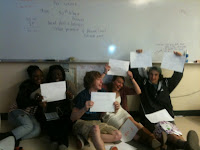Parents provide the best literacy

I admit becoming a parent made me more aware of what I loved and feared in education. I went through an intense stage of self awareness when my daughter entered kindergarten. I was so impressed by her excitement to learn. Her teacher of 30+ years experience was engaging, entertaining and very organized. Her mentoring led to my transformation and a decision to improve upon a few things. This teacher communicated with parents. Parents were not afraid or put aside. Every interested parent found a role to play in education (at least while their children are involved). It is difficult to organize but I will not give up on the idea that parents want to be involved in education in a positive way. If I don't give parents a role it isn't surprising to find them airing frustrations on Facebook or in other public forums. First, I need to improve how schools acknowledge the role that parents play in the home. In the Journal for the Educati...






